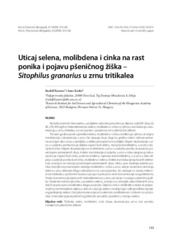Effect of Selenium, Molybdenum and Zinc on Seedling Growth and Frequency of Grain Weevil (Sitophilus granarius) in Triticale Grains
Uticaj selena, molibdena i cinka na rast ponika i pojavu pšeničnog žiška – Sitophilus granarius u zrnu tritikalea
| dc.contributor.author | Kastori, Rudolf | |
| dc.contributor.author | Kadar, Imre | |
| dc.date.accessioned | 2015-11-07T11:04:13Z | |
| dc.date.available | 2015-11-07T11:04:13Z | |
| dc.identifier.uri | http://arhiva.nara.ac.rs/handle/123456789/1331 | |
| dc.description.abstract | The effects of different doses (0, 90, 270, 810 kg/ha) of selenium, molybdenum and zinc microelements on their translocation and accumulation in grains, seedling growth and grain infestation were examined under field conditions on a calcareous chernozem soil. Thirteen years after the application of selenium, molybdenum and zinc, significant translocation and accumulation of these elements in the grain were established, indicating a long-term effect of these microelements on triticale plants. The highest degree of accumulation in grains and seedling shoots was found for selenium, then molybdenum, while the detected amounts of zinc were significantly lower. The degree of accumulation of all three microelements in the grain and seedling shoot increased as doses increased. Translocation index from shoot to grain at the grain-filling phase was the highest when zinc was used, then selenium, and the lowest when molybdenum was applied. The highest translocation index from the grain during germination into seedling shoots was obtained with zinc, then molybdenum and selenium. Translocation indexes of the investigated elements significantly decreased as the doses of elements increased. Dry weight of seedling shoots decreased as molybdenum and zinc in grain increased. High selenium concentration moderately stimulated seedling development, pointing out a high tolerance of triticale to higher concentration of this microelement at initial development stages. Infestatation with grain weevil was provoked by high concentrations of these microelements in the grain. High concentrations of zinc and selenium, in particular, significantly decreased the percentage of damaged grains, while molybdenum moderately increased their numbers. The effect of zinc and molybdenum may be attributed to their chemical effect, while selenium effect may also be referred to a negative effect of the volatile selenium compound. The effect of selenium, molybdenum and zinc contamination of grains on the seedling growth and frequency of grain weevil was different, and the emphasis was on selenium. | en |
| dc.description.abstract | Na karbonatnom černozemu, u poljskim uslovima proučeno je dejstvo različitih doza (0, 90, 270, 810 kg/ha) mikroelemenata selena, molibdena i cinka na njihovu translokaciju i akumulaciju u zrnu tritikalea, na rast ponika i zaraženost zrna pšeničnim žiškom. Trinaest godina posle upotrebe selena, molibdena i cinka utvrđena je njihova značajna translokacija i akumulacija u zrno, što ukazuje da je dugi niz godina nakon njihove primene značajan deo ostao u zemljištu u obliku pristupačnom za biljke. Stepen akumulacije u zrnu i u izdanku ponika bio je daleko najveći kod selena, manji kod molibdena, a znatno manji kod cinka. Stepen akumulacije sva tri elementa u zrnu i u izdanku ponika se povećao povećanjem primenjenih doza. Indeks translokacije iz izdanka u zrno u toku njegovog nalivanja bio je najveći kod cinka, zatim kod selena, najmanji kod molibdena, a iz zrna u toku klijanja u izdanak ponika kod cinka, molibdena i selena. Indeks translokacije ispitivanih elemenata značajno se smanjio povećanjem primenjenih doza. Masa suve materije izdanka ponika smanjila se povećanjem sadržaja molibdena i cinka u zrnu, dok je visoka koncentracija selena u zrnu delovala blago stimulativno na razvoj ponika, što ukazuje na visoku tolerantnost tritikalea u početnim fazama razvoja na prisustvo veće koncentracije ovog elementa. Visoka koncentracija ispitivanih mikroelemenata u zrnu uticala je i na pojavu pšeničnog žiška. Visoke koncentracije cinka, a posebno selena, značajno su smanjile udeo oštećenih zrna, dok ih je prisusutvo molibdena blago povećalo. Dejstvo cinka i molibdena može se pripisati njihovom hemijskom dejstvu, dok se u slučaju selena ne isključuje i odbojni efekat isparljivog jedinjenja selena. Uticaj kontaminacije zrna selenom, molibdenom i cinkom na rast ponika i intenzitet pojave pšeničnog žiška bio je različit, posebno u slučaju selena. | sr |
| dc.subject | Triticale | en |
| dc.subject | Selenium | en |
| dc.subject | Molybdenum | en |
| dc.subject | Zinc | en |
| dc.subject | Dose | en |
| dc.subject | Accumulation | en |
| dc.subject | Grain | en |
| dc.subject | Seedling growth | en |
| dc.subject | Grain weevil frequency | en |
| dc.subject | Tritikale | sr |
| dc.subject | selen | sr |
| dc.subject | molibden | sr |
| dc.subject | cink | sr |
| dc.subject | doze | sr |
| dc.subject | akumulacija | sr |
| dc.subject | zrno | sr |
| dc.subject | rast ponika | sr |
| dc.subject | naseljenost pšeničnim žiškom | sr |
| dc.title | Effect of Selenium, Molybdenum and Zinc on Seedling Growth and Frequency of Grain Weevil (Sitophilus granarius) in Triticale Grains | en |
| dc.title.alternative | Uticaj selena, molibdena i cinka na rast ponika i pojavu pšeničnog žiška – Sitophilus granarius u zrnu tritikalea | sr |
Files in this item
This item appears in the following Collection(s)
-
VOL 24 *No.2
http://www.pesting.org.rs/2009.php



